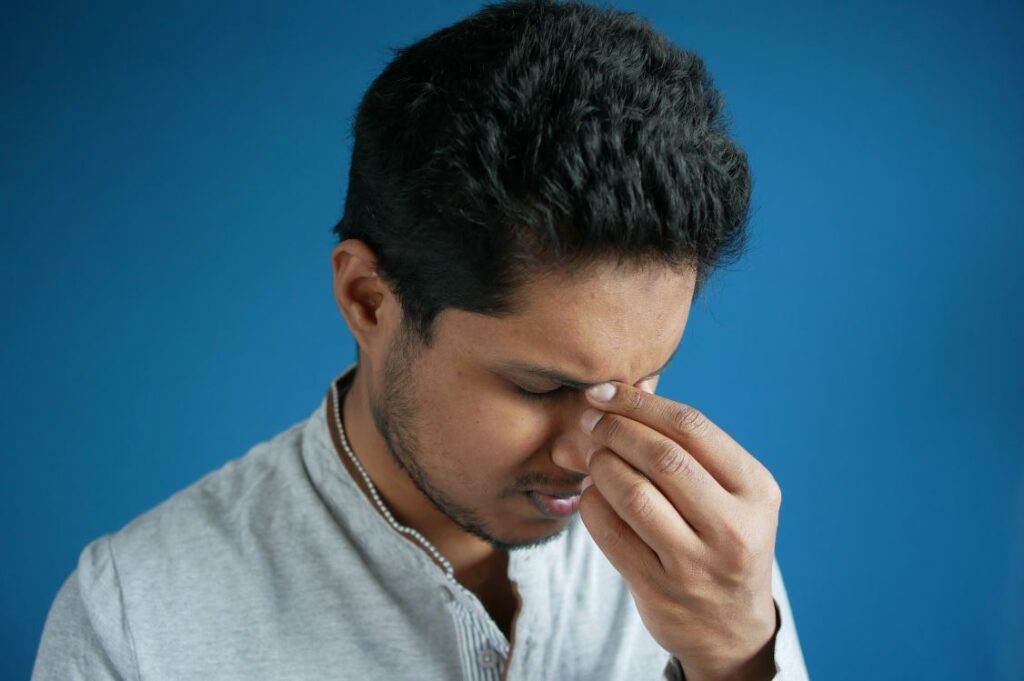
How to stop a nosebleed with a penny…likely an old wife’s tale? Nosebleeds are a normal part of life but they can be messy and frightening, especially for children. The sudden gushing of blood can be scary and a small amount of blood can look like gallons when it’s pouring out of the nose.
But it’s important to remember that nosebleeds are usually harmless and will stop on their own in a few minutes. You may not have to stop the nosebleed with a penny when you follow all the proper steps to safely stop the bleeding.
First thing to do with a nosebleed
The first thing to do is remain upright. This helps decrease the flow of blood through the nose and can help with clotting. It’s also important to teach kids to avoid picking their nose, which can cause bleeding. It’s also a good idea to keep kids calm so they don’t worry about the nosebleed.
Pinch the soft parts of the nose together with thumb and index finger to slow down the bleed and encourage the clot to form. This can be done while sitting or standing. It’s important to keep pinching for about 10 minutes without taking breaks to prevent the bleed from restarting.
An ice pack or a bag of frozen peas can be held against the bridge of the nose to help reduce swelling and bleeding as well.
If the nosebleed doesn’t stop, seek medical attention. If the bleed lasts more than 15 minutes or if your child loses a lot of blood that could fill up a cup, see a pediatrician as this may be a sign of a serious condition.
How to stop a nosebleed with ice
About one in six people get a nosebleed at some time during their lives. While they can be alarming, most nosebleeds aren’t a medical emergency and can be treated at home. It’s important to stay calm and follow the instructions for first aid.
Sit upright with the head tipped slightly forward and breathe through your mouth. This keeps the blood from draining down the back of your throat and potentially making you swallow or choke.
Use your thumb and index finger to firmly pinch the soft part of the nose (between the end of your nostrils and the hard bony ridge that forms the bridge) to put pressure on the blood vessels. This is usually where the bleeding starts and it’s important not to squeeze above the bony area of your nose because this won’t put pressure on the blood vessels. Continue pinching for 10 minutes and check to see if the nosebleed has stopped.
If the nosebleed isn’t stopping after ten minutes of pinching, apply a cloth-covered ice pack to the bridge of your nose. This can help constrict blood vessels and slow or stop the bleeding, particularly if there has been some trauma to the nose.
In addition, a cold compress can help reduce inflammation from any trauma or injury. If the bleeding continues to be heavy, it’s best to seek emergency care or call Westside Head & Neck to see an otolaryngologist. They can provide expert advice and care for your nosebleeds.
Can a nosebleed be dangerous?
Nosebleeds, also known as epistaxis, are a common occurrence and can happen to anyone at any age. While most nosebleeds are not a cause for concern and can be resolved with home remedies, some nosebleeds can be dangerous and require medical attention.
The most common cause of nosebleeds is dry air, which can cause the nasal membranes to dry out and crack, resulting in a nosebleed. Other common causes include trauma to the nose, allergies, medications that thin the blood, and high blood pressure.
Most nosebleeds can be treated at home by pinching the nostrils together and leaning forward slightly to prevent blood from flowing down the throat. Applying a cold compress to the bridge of the nose can also help to constrict blood vessels and stop the bleeding.
However, there are times when a nosebleed can be dangerous and require medical attention. If a nosebleed is severe and lasts for more than 20 minutes, or if blood loss is significant, it can lead to complications such as anemia, shock, or even death.
In rare cases, a nosebleed can be a sign of a more serious underlying condition, such as a blood clotting disorder, a tumor in the nasal cavity, or high blood pressure. If a nosebleed is accompanied by other symptoms such as dizziness, headache, or difficulty breathing, it is important to seek medical attention immediately.
Children are more prone to nosebleeds than adults, and parents should be aware of the signs of a dangerous nosebleed. If a child’s nosebleed is severe and lasts for more than 10 minutes, it is important to seek medical attention. Children who have frequent nosebleeds or who have a family history of bleeding disorders should also be evaluated by a doctor.
While most nosebleeds are not a cause for concern and can be treated at home, it is important to be aware of the signs of a dangerous nosebleed. If a nosebleed is severe, lasts for more than 20 minutes, or is accompanied by other symptoms, it is important to seek medical attention immediately. Parents should also be aware of the signs of a dangerous nosebleed in children and seek medical attention if necessary.
Why people get sudden nosebleed while sleeping
Nosebleeds that occur during sleep can be particularly alarming and disruptive. While the majority of nosebleeds are mild and do not require medical attention, it is important to understand the potential causes of nosebleeds while sleeping and how to prevent them.
One of the most common causes of nosebleeds while sleeping is dry air. During the winter months, the air inside homes and buildings tends to be drier due to the use of indoor heating systems. This dry air can cause the delicate skin inside the nose to crack and bleed. Similarly, sleeping in a dry climate or with a lack of humidity can also lead to nosebleeds at night.
Another potential cause of nosebleeds while sleeping is allergies. Allergic reactions can cause inflammation and irritation in the nose, leading to nosebleeds. Additionally, certain medications used to treat allergies can cause dryness in the nose, making nosebleeds more likely.
Infections, such as colds or sinusitis, can also cause nosebleeds while sleeping. These infections can cause the blood vessels in the nose to become inflamed and more susceptible to bleeding. Similarly, high blood pressure can also cause nosebleeds, especially at night when blood pressure tends to be higher.
In rare cases, nosebleeds while sleeping can be a sign of a more serious underlying condition, such as a blood disorder or tumor. However, in most cases, nosebleeds at night are not a cause for concern and can be easily managed with home remedies.
To prevent nosebleeds while sleeping, it is important to maintain a humid environment. Using a humidifier in the bedroom can help add moisture to the air and prevent the skin inside the nose from drying out. Additionally, avoiding irritants such as tobacco smoke and chemical fumes can also help prevent nosebleeds.
If you do experience a nosebleed while sleeping, it is important to stay calm and avoid lying down flat. Instead, sit up and lean forward slightly to allow the blood to drain out of the nose.
Pinching the nostrils together can also help stop the bleeding. If the bleeding persists for more than 20 minutes or is accompanied by other symptoms such as dizziness or difficulty breathing, seek medical attention immediately.

How long to wait after a nosebleed to sleep
One of the most common questions people have after experiencing a nosebleed is how long they should wait before going to sleep. The answer to this question depends on the severity of the nosebleed and whether or not it has stopped completely.
If the nosebleed is mild and has stopped completely, there is generally no need to wait before going to sleep. However, it is important to take certain precautions to prevent further bleeding. This includes avoiding blowing your nose, picking your nose, or bending over for several hours after the nosebleed has stopped. It is also a good idea to sleep with your head elevated, either by using an extra pillow or by propping up the head of your bed.
If the nosebleed is more severe and has not stopped completely, it is important to take certain precautions before going to sleep. This includes continuing to apply pressure to the nose for at least 10-15 minutes or until the bleeding stops completely.
You should also avoid blowing your nose, picking your nose, or bending over for several hours after the nosebleed has stopped. It is also a good idea to sleep with your head elevated, either by using an extra pillow or by propping up the head of your bed.
In some cases, it may be necessary to seek medical attention for a nosebleed. This is particularly true if the nosebleed is severe, lasts for more than 20-30 minutes, or is accompanied by other symptoms such as dizziness, light-headedness, or difficulty breathing. If you are unsure whether or not you need medical attention for a nosebleed, it is always best to err on the side of caution and seek medical advice.
In summary, the length of time you should wait before going to sleep after a nosebleed depends on the severity of the nosebleed and whether or not it has stopped completely. If the nosebleed is mild and has stopped completely, there is generally no need to wait before going to sleep.
Why some people get more nosebleed than others
There are several reasons why some people may be more prone to nosebleeds than others. One of the most common causes of nosebleeds is dry air. Dry air can cause the nasal membranes to become dry and cracked, making them more susceptible to bleeding.
This is why nosebleeds are more common during the winter months when the air is drier. People who live in dry climates or who use central heating systems may also be more prone to nosebleeds.
Another common cause of nosebleeds is trauma to the nose. This can occur from picking the nose, blowing the nose too hard, or from an injury to the nose. People who play contact sports or who have a job that involves physical labor may be more prone to nosebleeds due to the increased risk of trauma to the nose.
Certain medical conditions can also increase the risk of nosebleeds. People with high blood pressure, blood clotting disorders, or who take blood-thinning medications may be more prone to nosebleeds. Hormonal changes during pregnancy can also increase the risk of nosebleeds.
In some cases, nosebleeds may be a symptom of an underlying medical condition. For example, people with allergies or sinusitis may experience frequent nosebleeds due to the inflammation and irritation of the nasal passages. In rare cases, nosebleeds may be a symptom of a more serious condition such as a nasal tumor or leukemia.
There are also certain lifestyle factors that can increase the risk of nosebleeds. Smoking can irritate the nasal passages and increase the risk of nosebleeds. Drinking alcohol can also increase the risk of nosebleeds by dilating the blood vessels in the nasal passages.
If you are experiencing frequent nosebleeds, it is important to speak with your healthcare provider to determine the underlying cause. In some cases, simple lifestyle changes such as using a humidifier or avoiding picking the nose may be enough to reduce the frequency of nosebleeds. In other cases, medical treatment may be necessary to address an underlying condition or to stop the bleeding.
